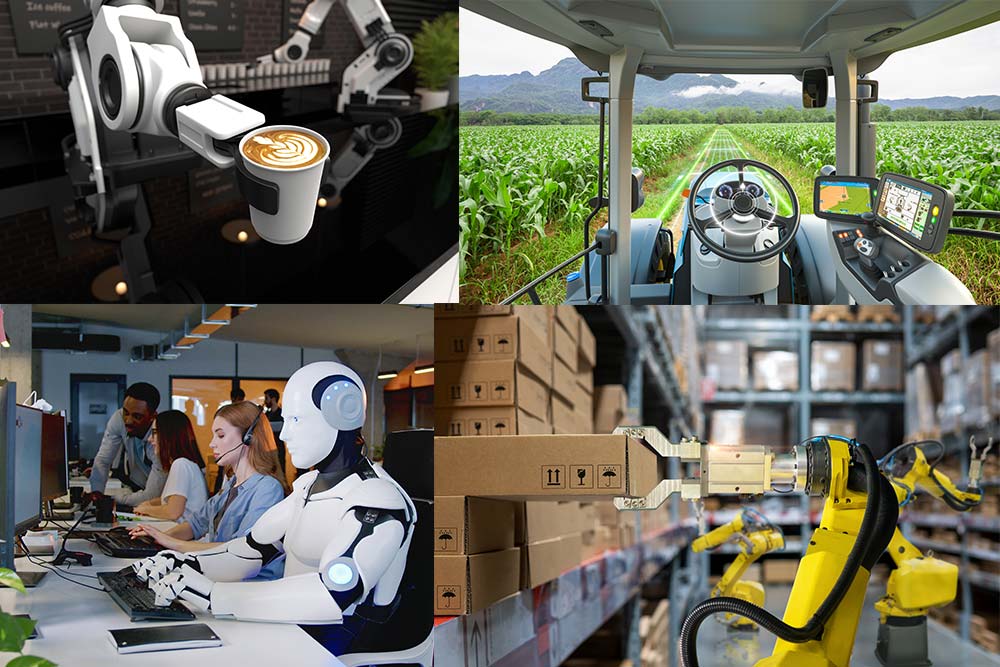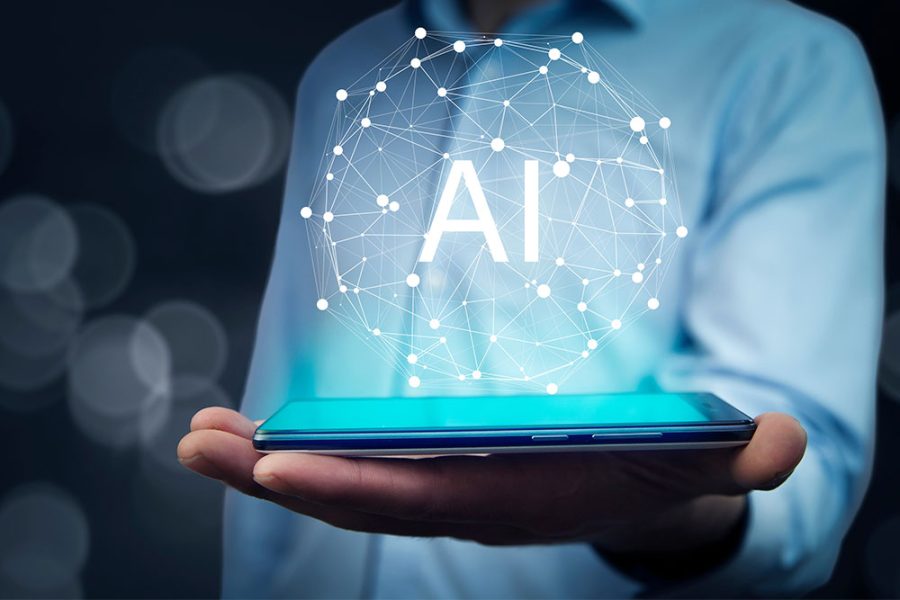 For centuries, people have adapted to working alongside the latest technological innovations and workplace advancements, many of which helped workers do their jobs more efficiently. Examples from the more distant past include printing presses, steam power, industrialization, production lines, and electricity.
For centuries, people have adapted to working alongside the latest technological innovations and workplace advancements, many of which helped workers do their jobs more efficiently. Examples from the more distant past include printing presses, steam power, industrialization, production lines, and electricity.
As we progressed through the 1980s and 1990s, computers became essential tools for a wide range of jobs in the sciences, engineering, healthcare, manufacturing, and professional services, helping workers perform tasks more quickly and accurately. More recently, computers have not only become more advanced but also smaller, now fitting into the palms of our hands.
Today, technology is progressing more rapidly, with artificial intelligence (AI) as the hottest new advancement. Over the past few years, companies in some sectors have begun introducing AI tools and solutions into the workplace to gain efficiencies and stay competitive.
Some of these tools are replacing human workers, often in jobs that are the hardest to fill. However, many more of these tools still require human workers to operate, manage, and program, requiring that companies hire new employees with specific skill sets or train existing employees.
The pace of this change is relatively slow because of the time needed to develop, test, and perfect these technologies before they can be used to perform critical tasks. But as AI technology is further refined and perfected, that pace will likely pick up, as will the need for employees with the skills necessary to use it.
Here are a few examples of the types of jobs companies are starting to use AI for:
Receptionists/Customer Service Representatives
AI has not completely replaced human receptionists yet, especially in small to medium-sized companies. However, the use of AI in automated telephone answering systems and online customer service chatbots has become more common over the last 20 years.
For instance, if you want to change your flight and call an airline’s customer service number, you might hear a computer-generated voice that offers you options, responds to voice prompts, and answers simple questions. However, for more complex issues, you’ll still be directed to a human customer representative.
In-person reception in office buildings is also generally still done by humans, but at least one company has already started developing AI-powered virtual receptionists displayed on touch screens at self-service terminals that, once perfected, could potentially change that dynamic.
In addition, a number of hoteliers have started automating check-in and check-out processes using AI-powered self-service kiosks or mobile apps, reducing (but not eliminating) the need for front desk staff.
Drive-Thru Attendants
Like receptionists, AI has not yet replaced humans in fast-food drive-thrus. However, several fast-food chains have started experimenting with using AI for drive-thru ordering.
Wendy’s appears to be all in with the rollout of Wendy’s FreshAI™, and it is now piloting a Spanish-language option in Florida and Ohio. However, McDonald’s recently ended its two-year test of an automated voice ordering system at 100 of its drive-thrus and said it will remove the technology from those restaurants, indicating that it’s not quite ready to commit to AI in the drive-thru.
In addition, nearly all of these fast-food restaurants, along with Starbucks, have mobile apps that customers can use to place online orders in advance and pick up in the drive-thru, some of which utilize AI-powered technology.
Tech Workers
In the tech industry, several companies have announced layoffs directly related to the growth of AI. Some have actually begun literally replacing staff with AI in certain roles, but an even larger number of companies are using the savings resulting from the layoffs to fund further investments in AI software and tools. Examples include:
- Intuit laid off around 1,800 employees earlier this year, stating it plans to invest the savings in AI technology.
- Dropbox, a file-hosting service headquartered in San Francisco, laid off 500 employees in 2023, partially because they lacked the skills needed to accommodate the rapid growth of AI.
- IBM announced last year that it plans to replace nearly 8,000 jobs with AI over the next five years.
- Dell is cutting an undisclosed number of sales jobs and reallocating those resources to its AI teams.
Retail Workers
It’s too early to say whether AI will replace all retail workers, but it is already being used to enhance various aspects of retail operations, including inventory management, price optimization, and e-commerce.
The workforce impacts of AI in retail are most noticeable with the fairly widespread adoption of self-checkout systems at grocery stores and general merchandise retailers like Target and Walmart. This early adoption of AI in retail has been primarily driven by rising labor costs and labor shortages, making AI a cost-effective alternative for many businesses.
Another example is IKEA’s use of autonomous drones for inventory management in their warehouses and distribution centers across Europe, which have eliminated the need for manual inventory by humans at those locations.
Automobile Factory Workers
According to an analysis by Oxford Economics in 2019, robots could replace up to 20 million manufacturing jobs worldwide by 2030. In the US, the automotive industry uses 38% of the manufacturing robots now operating in the country — more than any other sector — and has seen a 14% reduction in human labor due to automation.
From my personal experience, people in the auto industry have noticed this trend over the past 20 years, with automation improving to the point where humans are doing less of the hands-on work that was common in the mid-1900s. The use of manufacturing robots is less widespread in other industries but is a trend that is likely to grow in manufacturing sectors like aerospace, electronics, computers, food and beverage, and others.
Farm Workers
The agricultural industry is increasingly using automation and AI for a variety of jobs that were once done manually by farm workers, including:
- Managing and monitoring the health of crops, soil, and livestock
- Operating and optimizing irrigation systems
- Detecting pests and diseases
- Sorting and grading harvested produce
- Detecting and removing weeds
- Operating tractors and other equipment that plant seeds, apply fertilizers and pesticides, and harvest crops
The industry has also been facing serious labor shortages for years, which makes automation even more appealing and is driving increased innovation and adoption.
What Economic Developers Can Do to Help Ease the Transition to AI
According to research conducted by Ernst & Young LLP in 2023, 65% of US workers surveyed said they were concerned about losing their jobs to AI, and 66% said they were worried about falling behind at work if they didn’t know how to use AI tools.
Research published in the peer-reviewed sociology journal Socius in 2022 indicated that 14% of workers have already experienced job displacement due to automation or AI.
In response to the rise of AI across multiple industries and sectors, economic development and workforce development organizations have started taking action in their communities to help workers adapt to employers’ changing needs through AI-focused training, upskilling, and apprenticeships. Some examples of this include:
Michigan
In 2020, the Detroit Regional Chamber launched the Detroit Regional Talent Compact, a collaborative initiative with partners across the state.
The compact’s goal is to provide all residents with access to postsecondary education, which will lead to successful careers that help fill the region’s talent needs, including in AI-related fields.
Strategies focus on increasing access to education, increasing student success in postsecondary programs, supporting adults who are entering or returning to college, and supporting regional businesses seeking to upskill current employees while also attracting new talent.
South Carolina
The South Carolina Technical College System, which is comprised of 16 colleges across the state, operates two internationally renowned programs with a focus on developing a highly skilled workforce for a variety of industries:
- readySC™ provides customized recruiting and training solutions to companies that are relocating to or expanding within South Carolina.
- Apprenticeship Carolina™ helps employers set up registered apprenticeships where workers can “earn while they learn” new in-demand skills in a variety of industries through structured on-the-job training and job-related education.
California
TechSF is a workforce development initiative run by San Francisco’s Office of Economic and Workforce Development that offers free training and certification programs and job search support to people age 18 or older who are seeking careers in technology, including AI-related fields.
What Employers Can Do to Help Themselves
It’s important to remember that the US is experiencing a labor shortage caused, in part, by demographic shifts in our workforce as millions of Baby Boomers retire. As a result, many companies see technological advancements such as AI and automation as potential solutions to these hiring challenges.
The ability of companies to adapt to and implement AI or other technology solutions is becoming a necessary part of doing business if they want to evolve and grow. However, simply investing in new AI tools, software, and automation solutions alone is not enough. Employers must also invest in upskilling and training their existing employees to work with these new tools.
Examples of companies offering AI-related upskilling to their employees include:
- Amazon’s Upskilling 2025 Initiative is giving hundreds of thousands of its employees access to a variety of technology training and education in fields such as machine learning and mechatronics and robotics. Additionally, its AI Ready program offers eight different AI training courses to employees and the public, plus educational scholarships.
- Earlier this year, JPMorgan Chase & Co. announced that all new hires would receive AI training and funded an AI Maker Space for students at Carnegie Mellon University. “We really believe that AI will be the most transformative technology to our industry over the coming decade,” said David Hudson, the company’s global co-head for Digital and Platform Services.
- IKEA announced in April that it would provide AI literacy training to about 30,000 workers and 500 managers.
Unfortunately, this type of corporate investment in upskilling or reskilling employees is far from widespread, with LinkedIn’s latest workplace learning report finding that only 38% of US executives say they are providing AI training to employees.
As technology continues to evolve, training and education remain vital to preserving jobs, meeting workforce needs, and helping companies adapt and succeed in an increasingly AI-powered world. When I graduated from high school and entered college, I had to adapt to the increasing use of computers, which were the next big thing in technology at the time — just as AI is today.
The same principle applies: Companies and workers across many different industries must be willing to learn and adapt to AI or risk becoming obsolete. Technology has always progressed to help humans perform tasks more efficiently, and AI is just the latest step in that progression.
Learn more about Camoin Associates’ workforce development and talent attraction services
📍 Related Articles:




